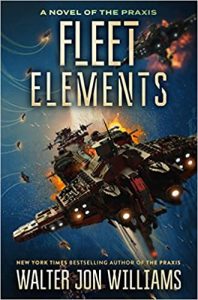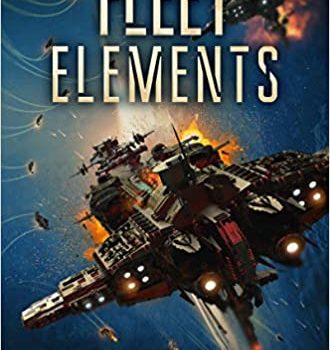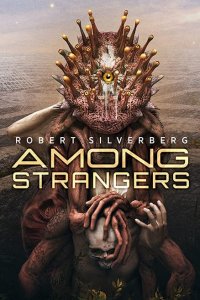Russell Letson Reviews Fleet Elements by Walter Jon Williams
 Fleet Elements, Walter Jon Williams (Harper Voyager 978-0-06-246706-1, 489 pp, $16.99, tp) December 2020.
Fleet Elements, Walter Jon Williams (Harper Voyager 978-0-06-246706-1, 489 pp, $16.99, tp) December 2020.
Two years ago, Walter Jon Williams returned to the setting and subgenre of his ingeniously unconventional Dread Empire’s Fall trilogy with the first of a set of sequels, The Accidental War (now branded A Novel of the Praxis). Though perhaps I should call the series “multi-conventional,” since, while the packaging and promotional language correctly signal “space opera” and “military SF,” the books also include strong elements of romance (if not romantic comedy), novel-of-manners, and even crime/intrigue-thriller.
The comparisons I settled on for the first three were to Patrick O’Brian’s Aubrey-Maturin wooden-ship naval adventures and Jane Austen’s distinctly non-military novels of manners, money, and marriage. Those comparisons still apply, but in the new novel, Fleet Elements, the balance does shift a bit. The armature of the original trio is the progress of the civil war generated by the disintegration of a long-lived, stable, multi-species interstellar empire ruled by the very, very organized Shaa. Their inflexible and occasionally brutal system of governance, the Praxis, had for millennia kept the peace and sustained a vast bureaucratic and military hierarchy, but with the Shaa finally gone (via species suicide), the empire’s rival species fell out over who would occupy the empty space at the top of the imperial hierarchy.
Gareth Martinez, a minor (but quite rich) aristocrat and major-league military talent (though professionally hindered by his middling social status), proved his worth as a naval officer in that civil war and become an official hero of the Praxis (which managed to persist, in name if not in effectiveness and cohesion). The Lady Caroline Sula, Martinez’s sometime lover and absolute equal in the military-genius business, also survived the late unpleasantness with distinction, though necessarily with a somewhat lower profile, not only because she ran a ragtag urban-guerrilla/assassination organization, but because she is not actually the semi-disgraced aristocrat she is supposed to be but an imposter with long-concealed criminal connections.
Martinez and Sula have worked separately to great effect in the civil war and spectacularly well together as a team in warship operations, but their emotional relationship, kept unstable by their personalities and external social conditions, has been worse than rocky. Seven years after the end of the civil war, both are comfortable enough in their new lives, but the successor regime is not the old Praxis – it is simultaneously rigid and wobbly, riddled with corruption, inefficiency, cronyism, and general incompetence. When a financial crash leads to rabble-rousing and the scapegoating of all Terrans, a new civil war breaks out, and the sometime lovers are pushed back into close contact, with predictable results, given their emotional volatility.
In Fleet Elements, the Terrans and their allies and a rump segment of the navy have escaped to provincial worlds and now must rebuild and reorganize a force capable of facing the mighty but hidebound old Praxis navy, which will certainly come after them. They must also consider what to do on the other side of victory, should it come: reform and refurbish the old regime or replace it with something beyond the Praxis? Thus much of the story deals with logistics and organizational charts and backroom politics – and then some deep-history back-story comes to light that makes questioning the wisdom of the Shaa and their Praxis more than a theoretical issue. “We don’t know how many wars they fought among themselves,” observes one rebel captain, “or how many other planets and species they wiped out before they met us.” (One suspects that the implications of this discussion will grow in significance in the next volume.)
This volume is more “military” in the everyday-procedural sense than the others, and since Martinez and Sula are now persons of importance, with new ranks and responsibilities, their emotional roller-coaster continues its wild ride in the gaps between stiff official social events, staff meetings, planning sessions, personnel selection, warship refittings, and training maneuvers. That wildness, coupled with the sometime-lovers’ volatilities and baggage, takes the pair to some dangerous places – but the central story line is directed at the inevitable confrontation with the forces of the Praxis, and the climactic sequence (the longest chapter in the book) is a set-piece space-navy battle that is meant to end the standoff between the human and anti-human factions. Here is offered an accounting of decisions made, shots fired, fleet elements maneuvered, ships lost, and the anxiety of command as the results of those actions pile up.
I confess that I found this chapter less gripping than the scenes of social interaction – the tedious (to Martinez and Sula), obligatory meet-the-staff dinner parties – or even the treatment of logistical operations in port. It is an unavoidable part of the story, though, and one that shows the professional-military side of the protagonists’ personalities, the combination of analytical insight, nerve, and competitiveness that lifts them above their fellow officers. And while the comparison with Patrick O’Brian’s novels remains apt, I now notice a contrast: O’Brian frequently jumps over the conventional set-piece action, providing instead a retrospective summary report of the result and whatever it might have cost or gained.
Despite the resolution of the immediate military problem, Fleet Elements does feel like the middle volume in a trilogy, with political, military, and personal conflicts not resolved but deepened and complicated. And, as the first trio of novels demonstrated, there is no guarantee of happily-ever-after when the curtain falls on the finale, which promises some grand and dangerous confrontations and revelations.
Russell Letson, Contributing Editor, is a not-quite-retired freelance writer living in St. Cloud, Minnesota. He has been loitering around the SF world since childhood and been writing about it since his long-ago grad school days. In between, he published a good bit of business-technology and music journalism. He is still working on a book about Hawaiian slack key guitar.
This review and more like it in the November 2020 issue of Locus.
 While you are here, please take a moment to support Locus with a one-time or recurring donation. We rely on reader donations to keep the magazine and site going, and would like to keep the site paywall free, but WE NEED YOUR FINANCIAL SUPPORT to continue quality coverage of the science fiction and fantasy field.
While you are here, please take a moment to support Locus with a one-time or recurring donation. We rely on reader donations to keep the magazine and site going, and would like to keep the site paywall free, but WE NEED YOUR FINANCIAL SUPPORT to continue quality coverage of the science fiction and fantasy field.
©Locus Magazine. Copyrighted material may not be republished without permission of LSFF.








